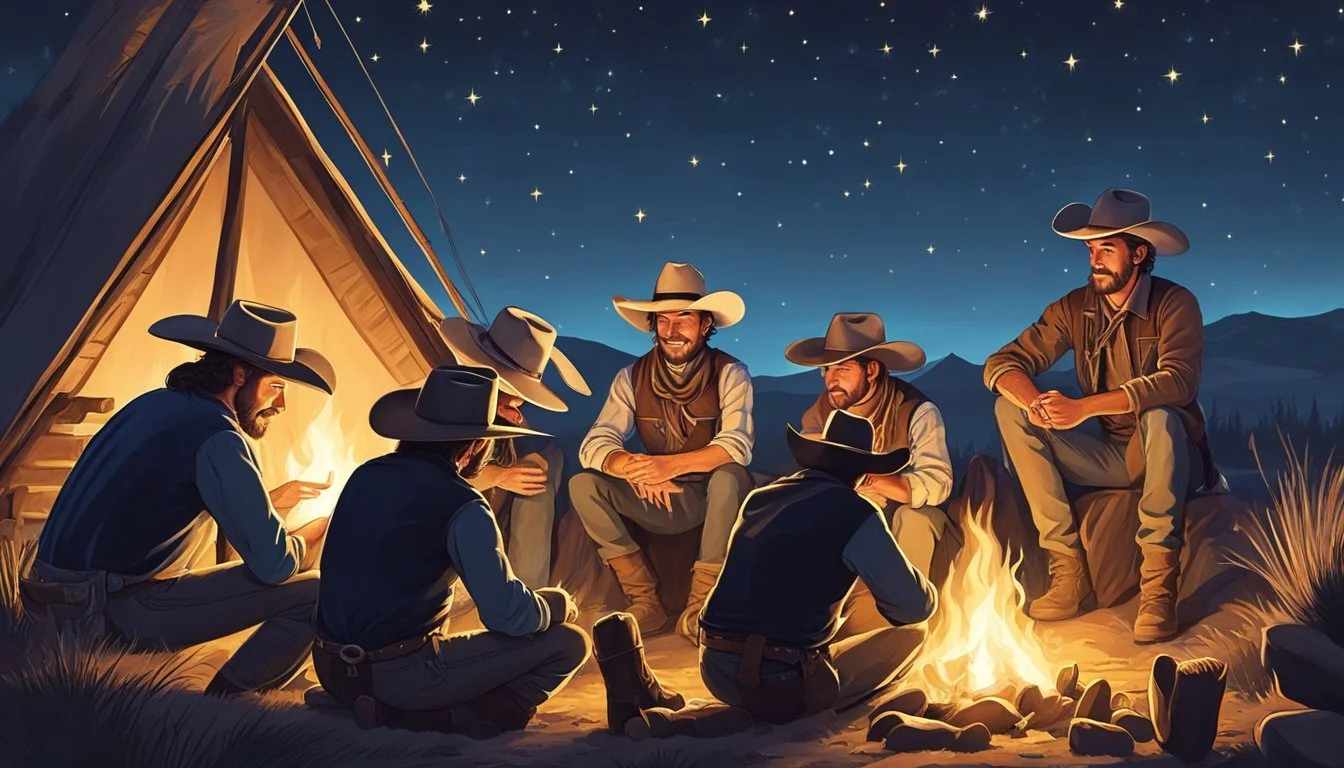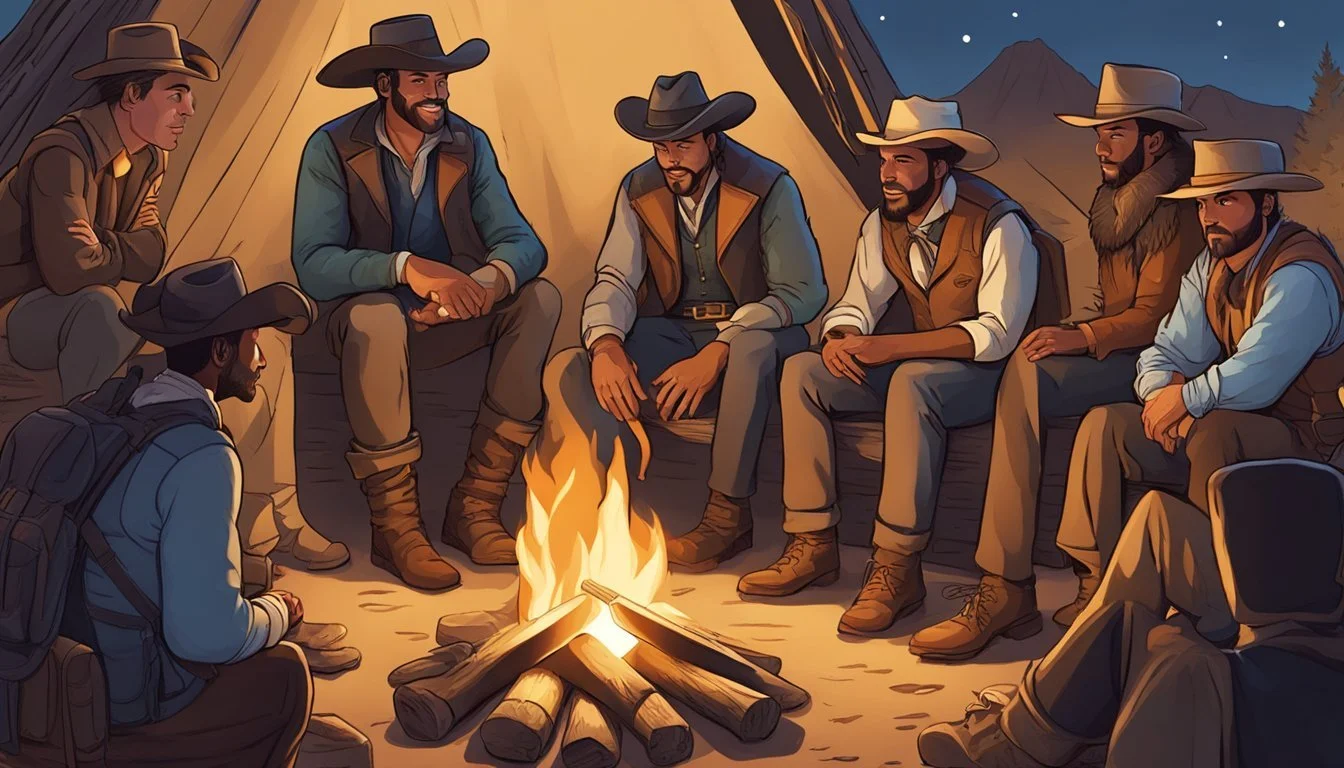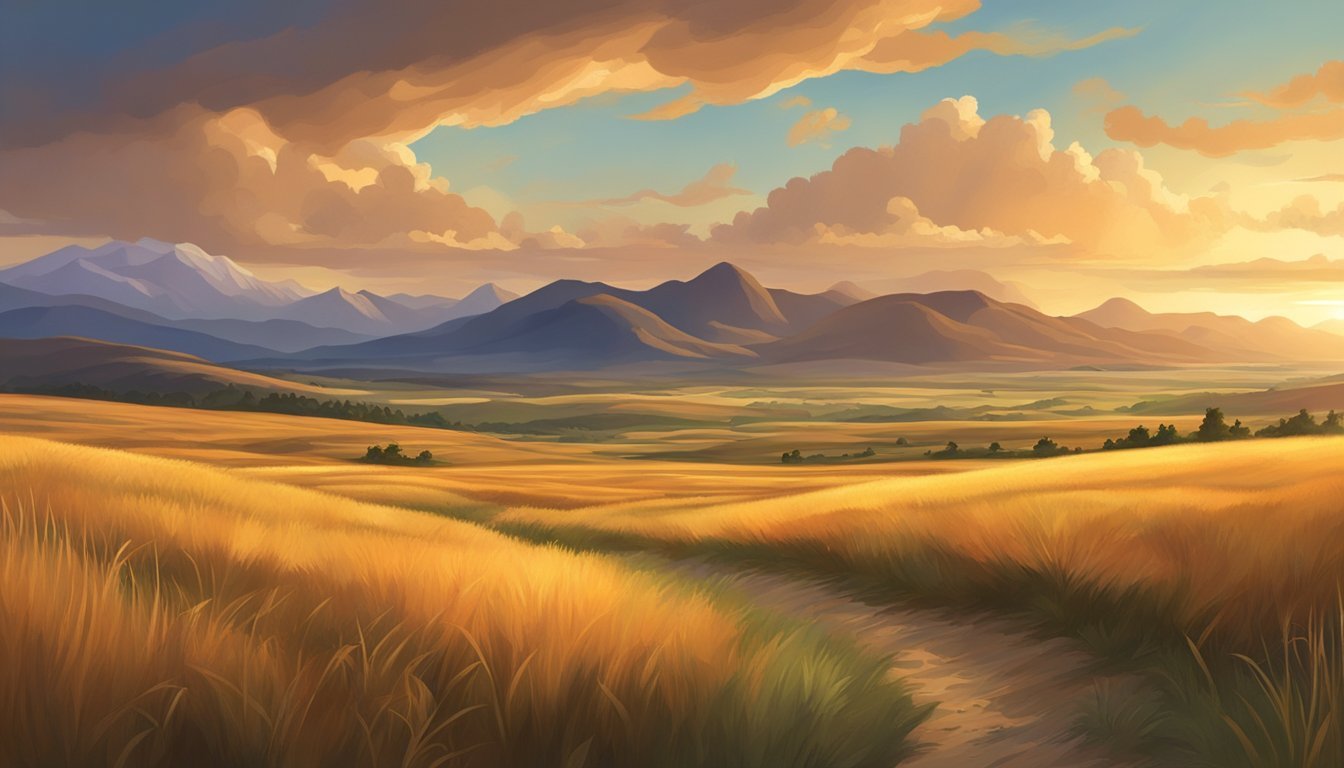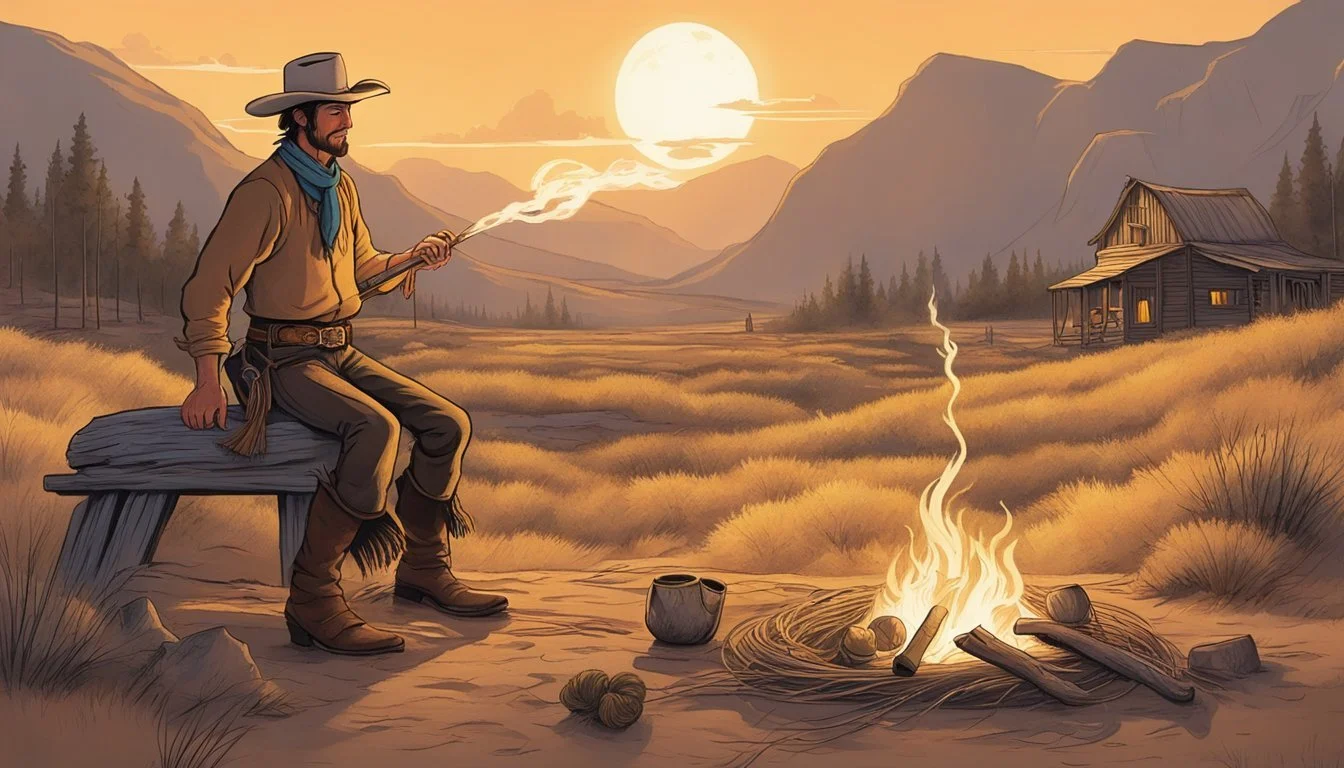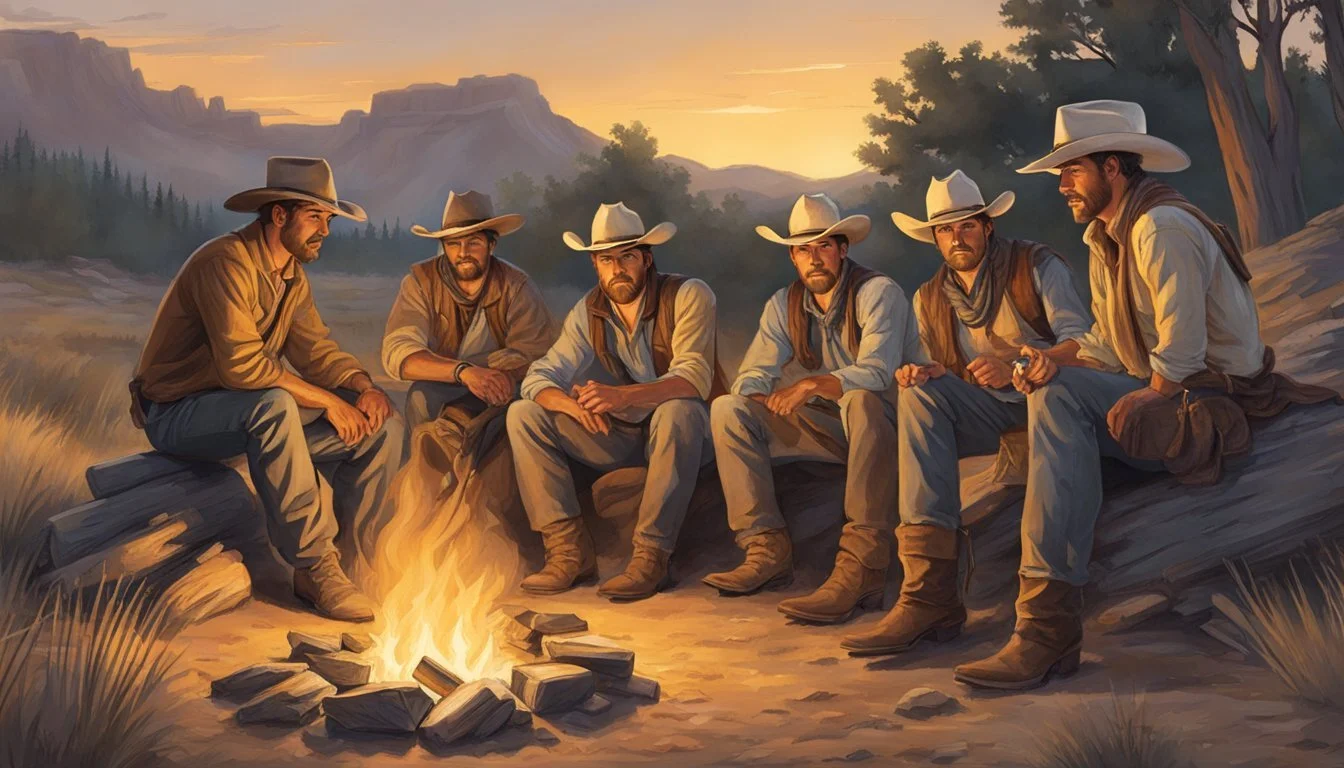The Tradition of Cowboy Yarns and Tall Tales
Unraveling American Folklore
The tradition of cowboy yarns and tall tales is an integral part of American folklore, particularly in the context of the Old West. These stories, which are characterized by their exaggerated nature, were originally a form of entertainment and a way to convey the larger-than-life persona of the American cowboy. The tales typically involve cowboys' superhuman abilities, and they often blur the lines between reality and fiction, serving as a testament to the imaginative spirit of the times.
Tall tales are not merely stories; they are a historical tapestry that captures the essence of frontier life. These narratives have roots dating back to Native American folklore and were propagated by the cowboys who, under the vast Western skies, spun yarns that mixed the mundane facts of their hard lives with outlandish embellishments. Over time, these tales became a celebrated part of American culture, often used to inject humor into the daily lives of those who faced the challenges of frontier living.
The prominence of tall tales in cowboy culture is evident in the way these stories have been embraced and adapted by authors and artists alike, reflecting the indomitable spirit and irreverent humor of the Old West. Today, cowboy yarns continue to capture the imagination, depicting the cowboys as heroes who embody the values of bravery, ingenuity, and an indomitable spirit, thus cementing tall tales as a cornerstone of American storytelling.
Historical Roots of Cowboy Tall Tales
Cowboy tall tales are a vibrant part of American folklore, intertwining the nation's history and culture with the larger-than-life exploits of folk heroes. These stories were deeply influenced by the American frontier experience and served to both entertain and convey societal values.
Influence of Early American Folklore
American folklore springs from a diverse tapestry of immigrant narratives, indigenous mythologies, and the hardships of colonial life. The frontier became a backdrop for the creation of a uniquely American set of stories. Legendary characters like Johnny Appleseed and Davy Crockett emerged, symbolizing the pioneer spirit and the connection between humans and the untamed natural world.
Paul Bunyan stands as a quintessential American folk hero, with stories that epitomize the enormity and challenges of taming the wilderness. A lumberjack of colossal stature and his equally imposing blue ox named Babe, Bunyan's tales are deeply entrenched in the logging folklore of the American frontier. His exaggerated exploits reflect the overwhelming task faced by settlers and the brawn thought necessary to transform the landscape.
Famous Folk Heroes and Their Legends
The evolution of cowboy stories brought forth characters like Pecos Bill, a larger-than-life cowboy who personified the rough and tumble ethos of the Wild West. According to legend, Pecos Bill performed incredible feats, such as riding tornadoes and using a rattlesnake as a lasso, which instilled a sense of adventure and bravado associated with cowboy life.
The tales of Baron Munchausen, although European in origin, found a parallel in American tall tales through their grandiose and fantastical narratives, contributing to the overall tradition of hyperbolic storytelling. These stories underscore the cultural exchange between settlers from different continents that shaped the American storytelling tradition.
Tall tales served to immortalize folk heroes in American culture, crafting an idealized version of the past that highlighted the virtues of bravery, strength, and a unique brand of humor. Through these tales, figures like Davy Crockett became emblematic of American rugged individualism, with their real-life actions often overshadowed by the mythos surrounding them. The embellished stories provided entertainment, moral lessons, and a sense of shared identity among those carving out a life in a new and untamed land.
Characteristics of Cowboy Yarns
Cowboy yarns serve as a captivating form of storytelling with roots in the Old West. They mesmerize audiences with their blend of humor, embellishment, and iconic characters set against the vast American frontier.
Humor and Exaggeration
Cowboy yarns are renowned for their humorous content and notable exaggerations. These tales often involve larger-than-life scenarios that are patently implausible, designed to entertain rather than inform. For instance, a cowboy might be depicted as lassoing a tornado or riding a lightning bolt -- feats that defy logic but capture the imagination.
Humor: Utilized to create a light-hearted, engaging narrative.
Exaggeration: Embellishments that elevate the story to mythical proportions.
Fiction Versus Fact
In cowboy yarns, the lines between fiction and fact blur, giving way to a unique storytelling tradition. While some elements may be based on real events or characters, they are typically adorned with fanciful details that emphasize the storyteller's creativity over historical accuracy.
Fiction: Invented elements that enhance the narrative's appeal.
Fact: Real-life inspirations that ground the tale in authentic Western experiences.
Typical Characters and Settings
The characters and settings of cowboy yarns are as essential as the stories themselves. Central characters often possess extraordinary skills or embody archetypal traits of the West, such as the solitary gunslinger or the cunning rustler. The landscape is another key element, with the vast, untamed expanses of the plains and deserts providing a dramatic backdrop to the unfolding exploits.
Main Character: Usually a cowboy with exceptional abilities or charisma.
Landscape: Portrayed as both beautiful and formidable, reflecting the challenges of frontier life.
Cultural Significance
Cowboy yarns and tall tales hold a distinct place in American folklore, intricately linked to the cultural identity, historical preservation, and reflection of national values.
Cowboy Yarns in American Identity
American Frontier: Cowboy yarns emerged from the experiences of those on the American frontier, symbolizing the ruggedness and adventurous spirit of the culture. These stories are imbued with the traits of bravery, ingenuity, and humor that many Americans associate with their national character.
Preserving History Through Tall Tales
Memory and Respect: Tall tales serve as vessels for preserving the memory of the American frontier. By exaggerating the realities faced by cowboys, these stories command respect for the hardships endured and achievements accomplished during westward expansion.
They transform historical figures into larger-than-life characters.
Their retelling keeps the history of the American frontier active in cultural memory.
Tall Tales and National Values
Reputation and Values: The content of cowboy yarns often reflects the values held in high esteem on the American frontier, including independence, strength, and resilience. These tales celebrate these values, contributing to the collective reputation of the culture.
They offer insights into the social ethos of the time.
They act as a mirror for the ideals that the society strives to uphold.
Storytelling Traditions
Cowboy yarns and tall tales are a colorful tapestry woven from the art of storytelling, thriving on the embellishment of mundane events into extraordinary narratives.
The Role of Campfires and Gatherings
Campfires and gatherings served as the beating heart of cowboy storytelling traditions, transforming them into hubs of social interaction and cultural transmission. These settings fostered an environment ripe for storytellers to regale their audiences with grandiose tales that encapsulated the essence of travel, adventure, and the rugged lifestyle of the frontier. Not only did they provide the warmth of community, they also served as platforms for the preservation and enhancement of memory, weaving together the real and imagined into the collective consciousness of cowboy culture.
Importance:
Community building: Strengthen bonds among cowboys.
Preservation: Keep traditions alive through engagement.
Elements often incorporated:
Music and poetry: Enrich the narratives.
Narrative Techniques and Styles
In the tradition of cowboy storytelling, narrative techniques and styles are as diverse as the tales themselves, with each storyteller bringing their own flavor to the tales they spun. Exaggeration served as a foundational tool, turning snakes into monsters and campfire sparks into raging infernos. Rhythmic language often resembled poetry, providing a lyrical quality that made stories more memorable and engrossing. Such techniques not only entertained but also served to emphasize the harsh realities of frontier life through elements that echoed the cadences of music and the measured beat of poetry.
Common techniques:
Hyperbole: Amplify the mundane.
Rhythmic narration: To create a poetic flow.
Tall Tales and Oral Tradition
The fabric of tall tales and oral tradition is intrinsically linked, as these exaggerated stories of frontier life were passed down orally from one generation to the next. They functioned as informal histories of a time marked by expansiveness and challenge, allowing listeners to engage with the shared heritage vividly and viscerally. These tales transcended mere entertainment, embodying the values, aspirations, and self-image of cowboy culture and the American frontier spirit.
Characteristics:
Exaggerated characters: Larger-than-life heroes.
Lesson-oriented: Often carry a moral message.
Representation in Literature and Media
Cowboy yarns and tall tales have found a distinct place within literature and media, evolving from oral storytelling to captivating audiences in print and on screens. These narratives often showcase the wit and ingenuity attributed to the Western frontier.
Tall Tales in Books and Poetry
Mark Twain, a notable figure in American literature, often included the essence of tall tales in his works, utilizing humor and exaggeration to explore themes of social critique and human nature. His narrative style in books like "Roughing It" and "The Celebrated Jumping Frog of Calaveras County" exemplifies the tall tale tradition in literary form, blending the lines between fact and fiction to amuse and engage readers.
Cinema and Television Portrayals
The tradition of cowboy yarns transitioned smoothly into cinema and television, becoming a staple of Western entertainment. The grandiose depictions of frontier life, as seen in films like "Pecos Bill" or the long-running television series "Gunsmoke," use these tales to enhance the allure of the Old West. The visual medium allowed for an expanded reach and reinterpretation of classic folklore elements associated with cowboy culture.
Influence on Modern Entertainment
The impact of cowboy yarns and tall tales is present in modern entertainment through various adaptations and inspirations. These stories serve as foundational components for contemporary works that wish to evoke the spirit of adventure and bravado that the original yarns celebrated. Audiences continue to be drawn to these tales, which now proliferate across genres, including video games and comic books, where the timeless allure of the tall tale continues to influence and shape narratives.
Gender and Diversity in Tall Tales
Tall tales of the American West are often dominated by cowboy heroes and out-sized male figures, but there is a growing recognition of the roles played by women and diverse characters in these narratives.
Women in Cowboy Narratives
In the traditional tall tales of the Wild West, women were often relegated to supporting roles, yet they were essential to the fabric of frontier life. Annie Oakley and Calamity Jane are prominent examples of women who defied the norms, their real lives giving rise to stories that blurred the lines between fact and fiction. Their tales contributed a female perspective to the predominantly male genre of cowboy stories, showcasing their sharpshooting and horsemanship skills.
Annie Oakley: Known for her marksmanship, Oakley became a national celebrity.
Calamity Jane: Her life stories contributed to the mythos of the American frontier, often involving acts of courage and survival.
Inclusive Tales of the American West
Diversity within tall tales extends beyond gender; it also includes the varied backgrounds of cowboys and frontierspeople. Individuals of African, Hispanic, and Native American descent have their own place in cowboy lore, challenging the single-story narrative. These stories illuminate the contribution of different cultures and ethnicities to the growth and legend of the West.
African-American cowboys: After the Civil War, approximately one in four cowboys were African-American, yet traditional tales have often overlooked their contributions.
Hispanic influences: Vaqueros, the original cowboys, were skilled horsemen from whom the American cowboys learned much of their trade.
Native American figures: Often depicted in simplistic terms, Native American characters are central to many legends, reflecting the complex interactions on the frontier.
Geographical and Environmental Influences
Tall tales in the cowboy tradition emerge from a mosaic of landscapes and climates, reflecting how geography shapes regional folklore.
Tall Tales from Different Regions
Texas: The heart of the cowboy legend, Texas, offers a wealth of tales featuring larger-than-life characters braving the sprawling, rugged terrain. Here, stories often highlight the relentless heat and vast deserts, where cowboys overcome outlandish challenges.
Great Basin: Stretching across Nevada and other states, the Great Basin's arid environment, with its vast plains and remote mountains, has birthed tales of cowboys contending with extreme isolation and navigating treacherous trails amidst the harsh landscape.
Environmental Factors in Story Creation
Landscape: The distinct features of a region's terrain—whether it's the wide-open plains of Texas or Nevada's rocky outcrops—are central to the plights and adventures of cowboy tales.
Cold: Tales from colder climates often emphasize the resourcefulness and resilience of cowboys facing blizzards and freezing night temperatures that test their survival skills on the trail.
Trail: The long cattle drives across unforgiving terrains have become the backdrop for many tall tales, allowing the storyteller to craft narratives of endurance and camaraderie in the face of environmental challenges.
Myth Versus Reality
Cowboy lore is rich with exaggeration, yet within it lie threads of historical truth. Readers must discern fact from fiction when considering the life and reputation of the American cowboy.
Analyzing Legendary Accounts
Legendary accounts of cowboys often portray them as fearless heroes who tamed the Wild West, but historical realities provide a more complex picture. Accounts from novels and films frequently elevate the cowboy to a status of near-mythical proportions, emphasizing traits such as bravery, rugged individualism, and a nomadic existence. Yet, records and photographs from the late 19th and early 20th centuries depict cowboys primarily as laborers who managed cattle. They worked long hours, faced harsh environments, and their day-to-day lives were less romantic than often depicted. Respect for the cowboy's role stems from their actual contribution to westward expansion and the cattle industry, rather than the embellished portrayals of folklore.
The Blurred Line Between Truth and Fiction
The distinction between rumor and reality is often obscured in the tales of cowboys. While Hollywood popularized an image of cowboys as predominantly white, tough, and always in a leadership role, reality shows considerable diversity among these figures. Mexican vaqueros, for instance, had a significant influence on the American cowboy's techniques and attire, yet this is often underrepresented in cowboy narratives. The reputation of cowboys has been shaped by these fictional narratives, which sometimes merge with historical truths. Consequently, the cowboy's image in popular culture often reflects a blend of genuine and fabricated attributes, leading to a cultural icon whose actual legacy is as much about the respect earned from verifiable achievements as it is about the allure of tall tales and heroic yarns.
The Art of the Tall Tale
The tall tale is an engaging form of storytelling that playfully distorts reality through extravagant exaggeration, crafting narratives that are as entertaining as they are impressively imaginative.
Language and Rhetoric
The artistry of tall tales hinges on the storyteller's command of language and rhetoric. The language employed is typically straightforward and is peppered with regional dialects or colloquialisms to ground the story in a relatable context. Rhetorical devices such as hyperbole are essential, as they amplify the story's elements to incredible proportions. Humor plays a critical role here, with punchlines often delivering exaggerated feats in a deadpan manner. Consider the punchline structure of a humorous cowboy yarn:
Setup: "This one time, I saw a coyote..."
Exaggeration: "...so fast, it could run along the edges of a lightning bolt without getting a single burn."
Punchline: "Yep, that's how we got those scorch marks on the plains!"
The Craft of Embellishment and Illusion
The craft of a tall tale is not just in the telling but in the strategic embellishment and illusion of mundane events. The storyteller takes a seed of truth and weaves around it layers of imaginative details that challenge credibility. The tale may be structured effectively using:
A believable setting: Often based on real locations to ease listeners into the narrative.
Credible beginnings: A plausible start to the story encourages listeners to buy into the premise.
Strategic exaggeration: Incrementally magnifying the story's core elements, blurring the line between fact and fiction.
Rhyme or rhythmic cadence: Sometimes, the storyteller might add a catchy rhythm or rhyme to give the tale a sing-song quality, aiding in its memorability.
Here is a simple-format table illustrating elements of a tall tale's craft:
Element Purpose Example Believable setting Ground the story "Out in the wild Montana plains..." Credible beginnings Engage the audience "I met a rancher there who..." Exaggeration Create awe "...could lasso a twister to water his crops." Rhyme Enhance memorability "He rode a bull named Tornado, never saw one that ornado."
Such stories are crafted to entertain, often leaving the audience marveling at the sheer audacity of the narrative. The craft lies not just in what is told, but in the telling itself, enveloping listeners in a vivid illusion crafted from the mundane to the marvelous.
Cowboy Yarns in the Digital Age
The tradition of cowboy yarns and tall tales has found a new pasture in the digital realm. This evolution preserves the memory of frontier narratives while embracing modern storytelling methods.
Online Storytelling Platforms
In the digital age, various online platforms serve as contemporary campfires for cowboy storytellers. Websites and social media allow for cowboy tales and poetry to be shared with a wider audience, transcending physical frontiers. For instance, digital libraries and eBooks provide access to historical collections like "Shorty's Yarns," preserving stories by Bruce Kiskaddon, which might have otherwise been lost. Additionally, these platforms enable the live streaming of cowboy storytelling events, fostering an interactive community experience reminiscent of the oral tradition but on a global scale.
The Evolution of Folk Narratives on the Internet
The intrinsic nature of cowboy tall tales to evolve with each retelling has flourished in the digital environment. Forums and blogs offer spaces where these narratives can grow and adapt, reflecting the ethos of the current era while rooted in traditional archetypes. Memory plays a crucial role in this process, with the internet acting as a collective repository for these folk narratives. As they are shared and reshaped, the quintessential elements of exaggeration and humor remain intact, ensuring that the spirit of the cowboy yarn thrives, not just survives, in the vast expanse of the digital landscape.
Profiles of Notable Storytellers
The tradition of cowboy yarns and tall tales is marked by both legendary campfire storytellers and prominent authors who have cemented this genre in American literature and folklore.
Legends of the Campfire
Campfire storytellers have long been a staple of cowboy culture, weaving tall tales that both entertain and convey the ethos of the West. These tales often revolved around folk heroes and legendary figures, amplifying their deeds to mythic proportions.
Cowboy Bob: Known for his "Campfire Conversations," Cowboy Bob was a classic teller of tall tales. Such storytellers would spin their yarns with a straight face, subtly challenging listeners to discern fact from fiction.
Grandfather Figures: In many Texas families, the elder patriarchs served as raconteurs, often accompanying their stories with music, most commonly a fiddle, embodying the archetypical image of a Western storyteller.
Authors Who Defined the Genre
A handful of writers took the raw material of cowboy tall tales and turned them into literary works, some of which continue to define American storytelling.
Mark Twain: Often considered the father of American literature, Twain was a master storyteller whose works such as "Roughing It" reflected the tall tale tradition through a lens of humor and satire.
Contemporary Chroniclers: Modern writers continue to preserve these narratives, compiling collections of cowboy stories, anecdotes, and tall tales that provide insight into the lives and humor of the American West.
These various narrators, both around the campfire and in print, have played a central role in keeping the spirit of the West alive through their engaging and exaggerated tales.


